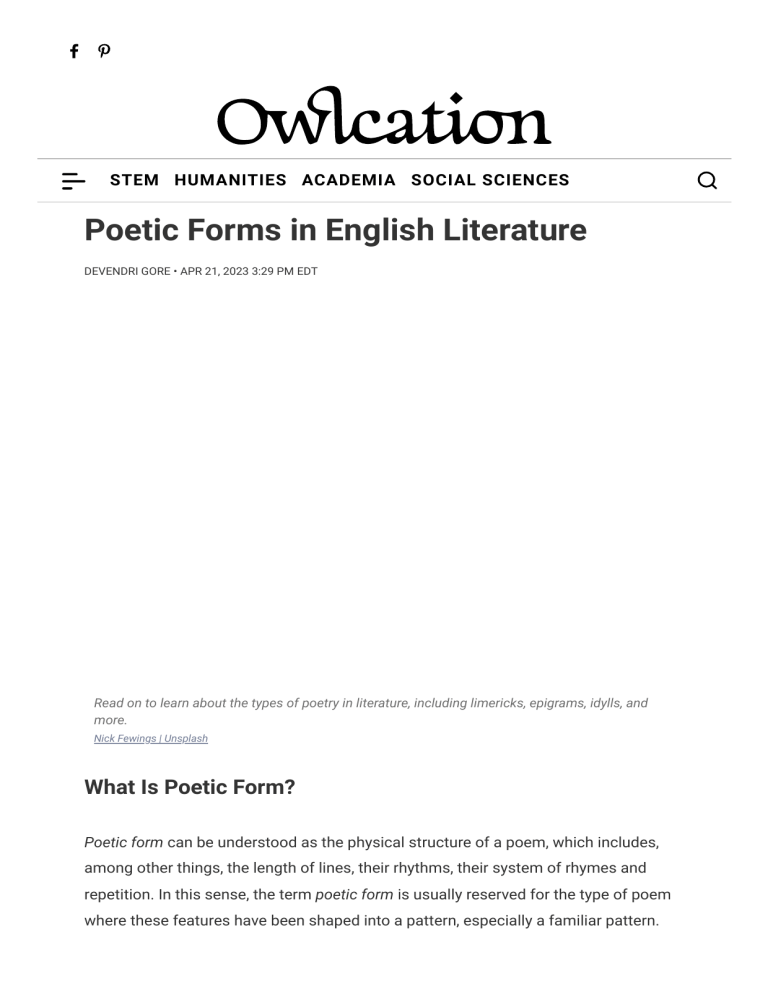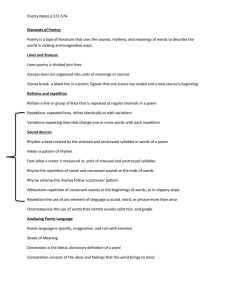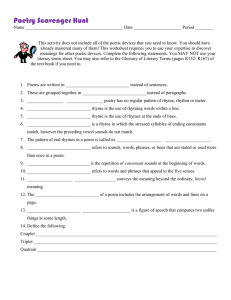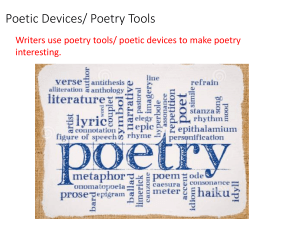
STEM HUMANITIES ACADEMIA SOCIAL SCIENCES Poetic Forms in English Literature DEVENDRI GORE • APR 21, 2023 3:29 PM EDT Read on to learn about the types of poetry in literature, including limericks, epigrams, idylls, and more. Nick Fewings | Unsplash What Is Poetic Form? Poetic form can be understood as the physical structure of a poem, which includes, among other things, the length of lines, their rhythms, their system of rhymes and repetition. In this sense, the term poetic form is usually reserved for the type of poem where these features have been shaped into a pattern, especially a familiar pattern. This article includes full definitions of 24 common English poetic forms with examples. 24 Common Poetic Forms 1. Sonnet 9. Ballade 17. Rubaiyat 2. Lyric 10. Clerihew 18. Rondeau 3. Ode 11. Eclogue 19. Pantoum 4. Elegy 12. Epigram 20. Lai 5. Idyll 13. Ghazal 21. Triolet 6. Epic 14. Haiku 22. Sestina 7. Ballad 15. Senryu 23. Blank verse 8. Acrostic 16. Tanka 24. Limerick Is poetry so difficult? Try approaching poems not as logical puzzles but as collections of rhythms, sounds, images, and moods. Elisa Calvet B. | Unsplash 1. Sonnet A poem of 14 lines that has been popular from the Late Middle Ages on. By the 14th century and the Italian Renaissance, the form became more well-defined under the pen of Petrarch, whose sonnets were translated in the 16th century by Sir Thomas Wyatt, who is credited with introducing the sonnet form into English literature. In general, sonnets have an 8-line stanza (called an "octave") followed by a 6-line stanza (a "sestet") with a break in between. The sestet usually offers a conclusion or resolution of what is presented in the octave. There are numerous kinds of sonnets, including the Petrarchan/Italian, Shakespearean/English, Spenserian, and Modern. A traditional Italian or Petrarchan sonnet follows the rhyme scheme abba, abba, cdecde. For instance: John Milton’s "On His Blindness” is a Petrarchan sonnet. The English or Shakespearean sonnet follows the rhyme scheme abab, cdcd, efef, gg. For an example, see William Shakespeare’s “Time and Love”. The Spenserian sonnet is composed of three quatrains (a 4-line stanza) and follows the rhyme scheme abab, bcbc, cdcd, ee. For instance, William Cullen Bryant's "Mutation" is a Spenserian sonnet. The Modern sonnet does not have a set rhyme scheme and sometimes appears in the "stretched" length of 16 lines instead of the traditional 14. Tweaks and experimentation in rhyme scheme mark this newer type of sonnet. "Professional Middle-class Couple, 1927" by Adam Kirsch is a Modern sonnet and employs the inventive rhyme scheme of two octaves of abbaabba. "High Talk" by W.B. Yeats is another example of a Modern sonnet, using simple rhyming couplets throughout and being comprised of an octave and a sestet. Yeats's sonnet is stretched in a different way: each line is about 15 syllables instead of the traditional 10. History of the Sonnet 2. Lyric A lyric is a form of poetry that is subject to being sung to the accompaniment of a musical instrument or that expresses intense personal emotions in a manner suggestive of a song. This type of poetry expresses the thoughts and feelings of the poet. For instance, see Edgar Allen Poe’s "Annabel Lee", May Swenson's "Women", and Christina Rossetti's "A Dirge". You will notice that each of these poems is quite different in terms of form and that May Swenson's poem does not rhyme. They are still considered lyrics in that they are very musical and portray strong personal emotions. 3. Ode The word "ode" comes from the Greek aeidein, meaning to sing or chant, and belongs to the long and varied tradition of lyric poetry. Originally accompanied by music and dance, and later reserved by the Romantic poets to convey their strongest sentiments, it can be generalized as a formal address to an event, a person, or a thing not present. For examples, see William Wordsworth's "Ode on Intimations of Immortality From Recollections of Early Childhood" and Percy Shelley's "Ode to the West Wind" (which also happens to be a sonnet with an unusual form). 4. Elegy An elegy, in poetic terms, is a funeral song. It can be thought of as a melancholy poem, which is written to mourn the death of someone, who is personal and close to the heart. The first elegies were written in Latin and Greek. Thomas Gray's "An Elegy Written in a Country Churchyard" and "Reprisals" by W.B. Yeats are good examples of elegies (though the latter criticizes as well as honors its subject). Country Churchyard 5. Idyll It is a short poem, descriptive of rustic life, written in the style of Theocritus's short pastoral poem the "Idylls". For instance, William Blake's "The Shepherd" and Lord Alfred Tennyson’s "Idylls of the King". 6. Epic The epic is a long, often book-length, narrative in verse form that retells the heroic journey of a single person, or group of persons. For example, Homer’s Iliad and Odyssey and the Epic of Gilgamesh. Illiad and Odyssey 7. Ballad It is a form of verse, often a narrative, set to music. Etymologically, the word ballad has been taken from Latin word ballare, which means dancing song. F.B. Gum has explained the definition of ballad as "a poem meant for singing, quite impersonal in material, probably connected in its origins with the communal dance but submitted to a process of oral traditions among people who are free from literary influences and fairly homogeneous in character." For instance, see John Keats's "La Belle Dame sans Merci" and Thomas Hardy's "During Wind and Rain". 8. Acrostic An acrostic is a poem in which the first, last, or other letters in a line spell out a particular word or phrase. The most common and simple form of this type of poem is where the first letter of each line spells out the word or phrase. For instance: Lewis Carroll's "A Boat Beneath a Sunny Sky" and Paul Hansford's "Stroud". (Hansford's poem is actually a double acrostic since the first and last letters of each line both spell out "Stroud".) 9. Ballade It was one of the principal forms of music and poetry in the 14th and 15th centuries in France. It contains three main stanzas, each with the same rhyme scheme, plus a shorter concluding stanza or envoi. All four stanzas have identical final refrain lines. The tone of the ballade was often solemn and formal, with elaborate symbolism and classical references. For instance: Andrew Lang's "Ballade to an Optimist" and "Ballade of Unsuccessful Men" by Hilaire Belloc. 10. Clerihew It is a whimsical, 4-line biographical poem invented by Edmund Clerihew Bentley. The first line is the name of the poem's subject, usually a famous person put in an absurd light. The rhyme scheme is aabb, and the rhymes are often forced. The line length and meter are irregular. For instance: W.H. Auden's "Academic Graffiti". 11. Eclogue It is a short pastoral poem, usually in dialogues. It first appeared in the idylls of the Greek poet Theocritus. For example, see Edmund Spenser's "Shepheardes Calender: April". 12. Epigram A very short poem, usually two or four lines long, with a simple rhyme scheme. The goal of an epigram is to encapsulate a brief bit of wit or wisdom in poetic form. For instance, see Alexander Pope’s "Epigram": I am His Highness’ dog at Kew; Pray tell me, sir, whose dog are you? 13. Ghazal It is a poetic form, consisting of rhyming couplets and a refrain, with each line sharing the same meter. It may be understood as a poetic expression of both the pain or loss or separation and the beauty of love in spite of the pain. The form is ancient originating in 6th-century Arabic verse. It is derived from the Arabian panegyric qasida. In style and content, it is a genre that has proved capable of an extraordinary variety of expression around its central themes of love and separation. It is one of the principal poetic forms which the Indo-Perso-Arabic civilization offered to the eastern Islamic world. For instance: Agha Shahid Ali’s "Even the Rain". Ghazal Presentation of Agha Ali Khan 14. Haiku It is a short poem which uses clarifying language to convey the essence of an experience of nature probably linked to the human condition. This is written in English in Japanese haiku style. For example, Jack Kerouac’s “Book of Haikus”. Here is a selection of Kerouac's haikus: Jack Kerouac: Collected Haikus 15. Senryu This is also a Japanese poetic form like Haiku. It is written about human nature, usually in an ironic vein. For instance, Don Haney’s “Back to School”. 16. Tanka Another Japanese poetic form. It is written in 5 lines. The theme of Tanka tends to lean towards personal feelings and the complexity of human interaction. Mamta Agarwal’s “An Island Within” and Seamus Heaney's "Tankas for Toraiwa" are good examples. 17. Rubaiyat It is a Persian form of poetry. It contains stanzas of 4 lines each. It is very open as there is no defining length of lines in it. Edward Fitzgerald used this form in his famous 1859 translation, The Rubaiyat of Omar Khayyam. Because of this, this form is known as Rubaiyat Quatrain in English. For instance, Robert Frost’s “Stopping By Woods on a Snowy Evening” is in Rubaiyat Quatrain. 18. Rondeau This is a poem of 15 lines. It is arranged in three stanzas of five lines (quintet), four lines (quatrain) and six lines (sestet) respectively. The first few words or the main phrase from the first line are repeated twice in the poem as a refrain. The rhyme scheme is aabba, aabA, aabbaA (Here A is the refrain). For instance: Thomas Wyatt’s “Request to Cupid for Revenge of His Unkind Love”. 19. Pantoum Here is a poem of fixed form consisting of 4-line stanzas with lines rhyming alternately. The second and fourth lines of each stanza are repeated to form the first and third lines of the succeeding stanza and the first and third lines of the first stanza form the second and fourth lines of the last stanza but in reverse order. Blas Falconer’s “A Ride in the Rain” is a good example. 20. Lai A lyrical, narrative poem of 9 lines written in octo-syllabic couplets. It deals with tales of adventure and romance. For example, see Walter Scott’s “The Lay of Poor Louise”. 21. Triolet It is a poem of 8 lines in which 1st, 4th, and 7th lines repeat, and 2nd and 8th lines also repeat. The rhyme scheme of the poem is AbaAabAB, capital letters representing the repeated lines. For instance, see Thomas Hardy’s “Birds At Winter” and Robert Bridge's "When we first met, we did not guess". 22. Sestina This poem consists of six stanzas of six lines each followed by a three-line envoi. The six ending words of first stanza are repeated as the ending words in other five stanzas in a set pattern. First stanza : ..1 ..2 ..3 ..4 ..5 ..6 Second stanza: ..6 ..1 ..5 ..2 ..4 ..3 Third stanza : ..3 ..6 ..4 ..1 ..2 ..5 Fourth stanza: ..5 ..3 ..2 ..6 ..1 ..4 Fifth stanza : ..4 ..5 ..1 ..3 ..6 ..2 Sixth stanza: ..2 ..4 ..6 ..5 ..3 ..1 Some good examples are Elizabeth Bishop’s “Sestina” and "Farm Implements and Rutabagas in a Landscape" by John Ashbury. 23. Blank Verse Blank verse does not have a specified amount of lines. Rather, it is verse written in iambic pentameter that does not rhyme. This type of poem has been utilized by many writers. For example, the famous "To be or not to be" soliloquy in Shakespeare's Hamlet, William Wordsworth's "Tintern Abbey", and Wallace Stevens's "Sunday Morning" are all written in blank verse. Iambic Pentameter Explained 24. Limerick The limerick is a short, single-stanza, 5-line poem utilizing a rhyme scheme of aabba. Almost all limericks are humorous and somewhat trivial. Some are blatantly crude. Good examples include Edward Lear's "Limerick #91" and Rudyard Kipling's "There was a small boy of Quebec". Sources and Further Reading Poetry 101: Learn About Poetry, Different Types of Poems, and Poetic Devices | Masterclass Poetry has been around for almost four thousand years. Like other forms of literature, poetry is written to share ideas, express emotions, and create imagery. What is Form in Poetry? 10 Poetic Forms to Try | Writers.com There are countless forms of poetry in the world, but how do you write any of them? Here's a formal inquiry into form, meter, and lineation. Glossary of Poetic Terms | Poets.org Browse this list of poetic terms, including common literary devices and poetic forms and techniques. © 2018 Devendri Gore Comments Marina on January 07, 2020: Very useful Co-yun on January 05, 2020: Is erasure poetry a poetic form too? Arya on October 25, 2019: It is so useful Jay Tazz on July 17, 2019: Its Awesome Paul Mashach Charles on June 24, 2019: It's very usefull for a literature student to taste a brief introduction about poetry... Phuntsho on June 01, 2019: It helps me to get the answers easily and it's awesome . on April 13, 2019: Cool Eli on February 18, 2019: Cool! I on January 14, 2019: Its useful to do my works in literature sarfraz ahmed on November 06, 2018: its good artical Jane Juarez on September 18, 2018: It helps me to do my homeworks and it is useful article. Gauri Sharma on May 26, 2018: very nice and useful article Nitin Renu Agarwal on April 21, 2018: Useful Article Dhruv mittal on March 31, 2018: nice article DAVID on March 30, 2018: Enlightening & informative Pushkar tyagi on March 30, 2018: Very useful Raghav Goel on March 29, 2018: AWESOME Karun Gaur from India on March 29, 2018: Nice Article. Recommended Articles 15 Types of Short Poetic Forms With Examples Characteristics of Romanticism in English Literature Characteristics of Middle English Literature The Significance of Studying Postcolonial Literature Seven Common Features of Old English Literature g Comparing Two or More Poems for a Literature Essay Privacy Policy · About Us · Editorial Policy · Terms of Use © 2023 The Arena Media Brands, LLC and respective content providers on this website. HubPages® is a registered trademark of The Arena Platform, Inc. Other product and company names shown may be trademarks of their respective owners. The Arena Media Brands, LLC and respective content providers to this website may receive compensation for some links to products and services on this website.




